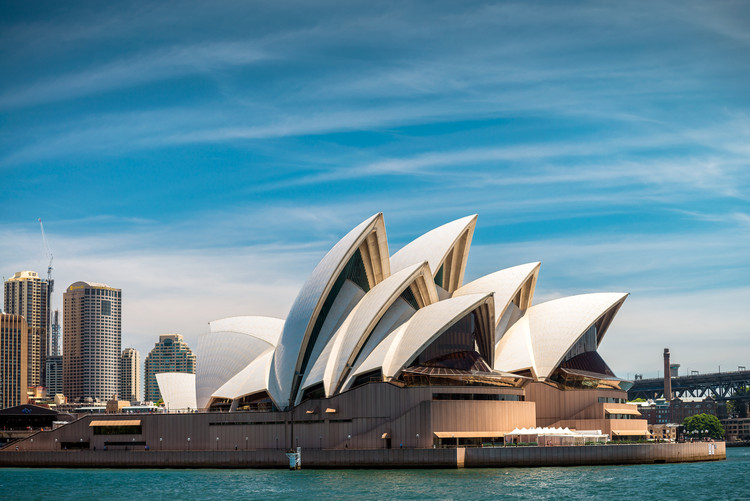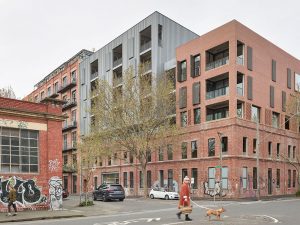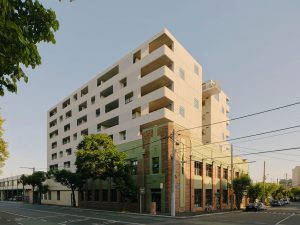
27 Dec Good, better… excellent? The challenges of navigating design quality through planning policy and assessment.
This article was first published in the VPELA Revue magazine, October 2023.
Excellence in the Planning Scheme
Requirements for design quality, excellence, exemplary and outstanding design are increasingly prominent in Victorian planning policies, reflecting the growing awareness of design as a pivotal success factor in built environment interventions.
In Port Phillip’s new format Planning Scheme, Clause 15 promotes excellence in the built environment, DDO23 (1-7 Waterfront Place) aims to achieve architectural design excellence; and DPO2 (St Kilda Marina) seeks to ensure that redevelopment achieves innovative and sustainable design excellence and high-quality architecture, public realm and landscaping outcomes. Requirements include for built form to achieve design excellence, and even car parking should demonstrate design excellence. DDO26 objectives state that new developments should achieve urban design and architectural excellence.
Clause 02.03 (Strategic Directions) envisages Fishermans Bend as a place of design excellence, supported by design excellence strategies at Clause 11.03-6L-04, including varied built form typologies; fine grain, pedestrian scale environments; buildings (that) contribute to a high quality public realm; spaces for people to meet, gather, socialise, exercise and relax; and variation in massing, building height, and roof forms. Clause 11.03-1L-04 seeks to create an attractive boulevard (along Kings Way) by ensuring excellence in the design of new buildings and the public realm.
Yarra’s Clause 21.05-2 (Urban Design), Strategy 17.2 lists architectural design excellence as a criterion for potential additional height, alongside others such as ESD, public realm enhancement and high quality adaptive re-use. Merri-bek’s DDO26 states that built form over 8 storeys must be of exemplary design quality (i.e. substantially superior to an acceptable design). Knox’s DDO9 supports design objectives for high quality, innovative architectural design, stating that any building over 4 storeys must demonstrate that the design is of exceptional quality and would exceed the high design quality already expected within the centre. The recent Bellarine Peninsula Statement of Planning Policy states that in Activity Centres, built form will achieve outstanding urban design outcomes.
‘Excellence’ is defined as the quality of being outstanding or extremely good, implying a certain level or benchmark to be achieved and demonstrated. ‘Exemplary’ is serving as a desirable model; very good (also reflecting benchmark status). ‘Quality’ is the standard of something as measured against other things of a similar kind; the degree of excellence of something; while ‘outstanding’ and ‘improving’ also suggest comparative assessment.
So the first challenge: how do we know if a design proposal is excellent, outstanding, or high quality?
Excellent, good or better?
The OVGA leads the discourse on design quality in Victoria’s built environment. Its publications raise awareness of ‘good design’ (rather than focussing on ‘excellence’), its benefits, its value and how to achieve it. It states that good design comes in many forms and is defined by much more than how something looks. It improves how it works, creates additional benefits and elevates how people feel, creates inspiring places and greater lasting financial value – and looks and feels good[1].
The OVGA facilitates processes that achieve better design outcomes, towards ensuring a better quality environment and a more liveable Victoria. It informs better designed and performing buildings, better spaces, and cities and towns that are better to live in.
So, the emphasis is on ‘better’, ‘improving’, and ‘good’ outcomes – and processes which support these, rather than ‘excellence’ or achieving certain standards. There is no fixed, definitive standard for good design or design excellence, and the assessment of design is at least partially subjective. In Design Review processes, panellists often have differing views on the same design.
The NSW Integrated Design Policy Better Placed also focuses on ‘good design’, which is not just how a place looks, but how it works and feels for people. Good design creates better places that maximise public value and contribute to the well-being of individuals and the community.
Better Placed is broad-ranging and integrated, encompassing context, functionality, performance, social outcomes and value, and it focuses on better outcomes. It refers to ‘Design Excellence’ for projects that have progressed through a formalised Design Excellence process, to achieve that status – rather than as a general objective or requirement.
Our second challenge then: should policy be requiring design excellence, or focussing on good design, or improving outcomes?
What does excellence look like?
The Sydney Opera House is an outstanding, excellent design outcome (but compromised in its implementation). The Guggenheim, Bilbao is another internationally recognised design triumph, but is criticised for its visual dominance and functionality[2]. Federation Square’s design won a major international competition, and has been highly successful, but is not without its critics. Design excellence is not definitive or absolute, and individual projects may encompass varying degrees of design quality.

Guggenheim Museum, Bilbao, designed by Frank Gehry Associates (image source: Dezeen).
While they reflect design excellence or ‘outstanding’ design, these landmark, civic buildings are not relevant as benchmarks for most development proposals.
The third challenge then: if we are seeking better, or even excellent development outcomes, what are we comparing to, and what should the benchmark be?

Federation Square, Melbourne, designed by LAB Architecture Studio (image source: ArchitectureAU).
Should design quality be evaluated against other projects of the same type, in a similar context? But even then, project conditions vary widely, and good design responds well to project constraints.
The Victorian Architecture Awards provide a valuable picture of design excellence across multiple building types. Awarded multi-unit housing projects in 2023 are described as austere and robust externally, but with considered detail and materiality. The citations span responses to context, internal amenity, ESD, communal space, social interaction, and financial sustainability, while the main award winner challenged the Council, (by) rejecting the default setback of new additions from the existing street wall[3]. Good design sometimes challenges other planning policies or standards.

Kerr Street Residences, designed by Kerstin Thompson Architects – Winner, Best Overend Award for Residential Architecture – Multiple Housing, Victorian Architecture Awards 2023 (Photography: Derek Swalwell / Source: Australian Institute of Architects).
Guiding good design
VCAT has found that high quality or architectural excellence means high quality having regard to what planning policy seeks to achieve in an area, and that the consideration of design excellence must be focused entirely on those matters encompassed within the planning scheme, and that issues of individual taste or preference for architectural styles are irrelevant.[4]
The Planning Scheme, reasonably, provides limited guidance for producing or evaluating design quality. For example, the design excellence strategies at Port Phillip’s Clause 11.03-6L-04 are relatively basic and very broad, and will not ensure design excellence.
Design guidance tends to focus on ‘basic’, pragmatic provisions, because design skill, craft, experience, intelligence and innovation, and the variability of context and project types, cannot be captured in a ‘how to’ manual. The Urban Design Guidelines for Victoria focus on functional and configurational aspects, and do not mention excellence. Design Excellence publications by Casey and Darebin, for example, are high-level and integrated, like Better Placed, or focus in on specific building types to allow more targeted, pragmatic guidance.
So the fourth challenge: how can we provide a reliable, consistent and meaningful framework for evaluating good design?

38 Albermarle Street, Kensington, designed by Fieldwork – Winner, Award for Residential Architecture – Multiple Housing, Victorian Architecture Awards 2023 (Photography: Tom Ross / Source: Australian Institute of Architects).
Excellent vs acceptable
Responsible authorities must decide whether a proposal will produce acceptable outcomes in line with the Planning Policy Framework[5], in the interests of net community benefit and sustainable development[6].
This articulates a tension, between increasing requirements to deliver and demonstrate excellence (sometimes in comparison to ‘high quality’ or ‘good’), within a Planning Framework that facilitates ‘acceptable’ outcomes which provide a net community benefit; and between an ‘excellence’ standard to be achieved, and processes of design improvement or betterment.
Our fifth challenge: how do we resolve the tension between ‘acceptable’ and ‘excellent’?
Advancing design through policy
We can work to address these challenges through:
Framework
A state-wide, comprehensive framework which defines good or excellent design, articulates how these can be achieved in different contexts, explains the community benefits they provide, and provides effective tools for guiding and evaluating design quality.
Policy
Embedding this Framework in a consistent, integrated design policy which is embedded in the Planning Scheme, utilising consistent terminology and clear articulation of expectations.
Evaluation method
A design evaluation framework, as NSW has developed[7], providing a comprehensive set of indicators, which support a rigorous process of design assessment, as well as a policy monitoring tool.
Quantifying design quality is fraught with uncertainty and subjectivity, and runs counter to the elusive, creative nature of the design process and outcomes. Design evaluation depends on expertise, debate and discourse. However, an evaluation method would provide appropriately broad-ranging and consistent parameters for considering and assessing design, in line with policy settings.
Discourse and design advocacy
Ongoing promotion of good design to reinforce its value and benefits, while communicating how better design looks, functions and performs.
Our collective handling of design in planning processes requires more discourse, debate, testing and analysis – let’s continue this essential discussion on good design in the built environment.
References:
[1] Office of the Victorian Government Architect, Good Design, https://www.ovga.vic.gov.au/good-design
[2] Alyn Griffiths, Frank Gehry’s Guggenheim Museum Bilbao is “the greatest building of our time”, Dezeen, 18 May 2022.
[3] Australian Institute of Architects, 2023 Victorian Architecture Awards – Results, https://www.architecture.com.au/awards/2023-awards/2023-vic-architecture-award-winners?utm_campaign=skedlink&utm_medium=button&utm_source=skedlink
[4] VCAT Order, Zak Group Pty Ltd vs Yarra City Council, VCAT Reference P196/2017, 27 July 2017.
[5] Victorian State Government (DELWP), Using Victoria’s Planning System, October 2022.
[6] Yarra Planning Scheme, Clause 71.02 Operation of the Planning Policy Framework.
[7] Government Architect NSW, Evaluating Good Design, https://www.governmentarchitect.nsw.gov.au/guidance/evaluating-good-design

